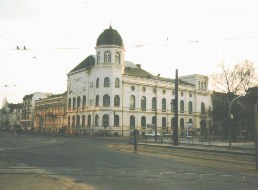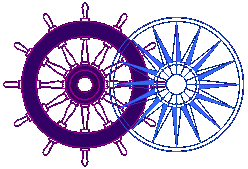 The Rostock Maritime
Museum – The Rostock Maritime
Museum –
Schiffahrtsmuseum Rostock

The museum was founded in 1968 as a museum of shipping history. The museum is
divided in two branches. The main branch, exhibiting the history of shipping, is housed in a 19th
century building in the centre of Rostock. The second branch is situated in an old merchant ship,
built in the 1950s in Rostock. There, the history of shipbuilding through the centuries is
exhibited. The museum is especially proud of its large collection of "captain's pictures", detailed
portraits of ships, painted for their captains in various techniques, including water-colours, oil,
and even executed in silk embroidery. The museum's work is not only concentrated on organising
exhibitions, but also scientific research and the exchange of these results.
Schiffahrtsmuseum Rostock, Im Steintor, August-Bebel-Straße 1, D-18055 Rostock,
Germany, tel 49-381-4922698, fax 49-381-27254, Opening hours: Tuesday - Sunday,
10:00-18:00
The Department of Ship archaeology (Schiffsarchäologie) at the museum
In 1994, the Department of Ship archaeology was founded at the Schiffahrtsmuseum in Rostock. The
main task is the prospection of ship wrecks along the coast of Mecklenburg- Westpommerania. This
department provided for the first time an institute which concerned itself with maritime
archaeology, especially the examining of boats and ships in the German Baltic coastal region.
Emphasis is placed on the examining of ship building techniques and the history of shipping in the
16th century, based on archaeological sources. It is at this level that the international exchange
of information takes place because, for example, many finds have been made in Sweden. The first
results were collected from a stranded wreck sunk in 1565 off Mukran
(on the isle of Rügen). At present we are still looking for a Swedish ship, the FINSKA FALKEN, off
Rostock -Warnemünde.
The work of the department is not only limited to the examination of ship wrecks, but also
concerns itself with other maritime things, for example underwater barriers. In 1995 a report was
produced about the so-called "stone box barriers" in the Rostock overseas harbour. The close
contact to sport divers, fishermen and underwater construction workers provided the initiative for
the creation of a questionnaire which made the passing on of information to the State National
Trust office much easier.
During the former GDR times, diving even for scientific reasons, was almost totally stopped by
the border laws. Despite this, the Schiffahrtsmuseum has a series of information about wrecks which
have been found in the Baltic, and together with the Department of Information at the University of
Rostock, has developed a databank containing all wrecks with the relevant information pertaining to
them. This databank is comparable to other such databanks in the Baltic region.
As there is a certain amount of danger with ship archaeology, we try to do as much work as
possible with underwater technology instead of divers. In cooperation with the Institute for Marine
Technology and Shipbuilding at the university, equipment was developed and tested, which greatly
eased our work underwater. As there is no formal academic training in Germany in the field of ships
archaeology, the department has developed a curriculum together with the Swedish marine
archaeologist Carl Olof Cederlund.
Based on this, the first Ship archaeological Seminar in Germany at
the University of Rostock took place in 1996. This course is to be continued at the university in
the future. We are very interested in future cooperation between marine archaeologists in the
Baltic region.
by Maik Springmann,
December 1996
rev jan '03 |
